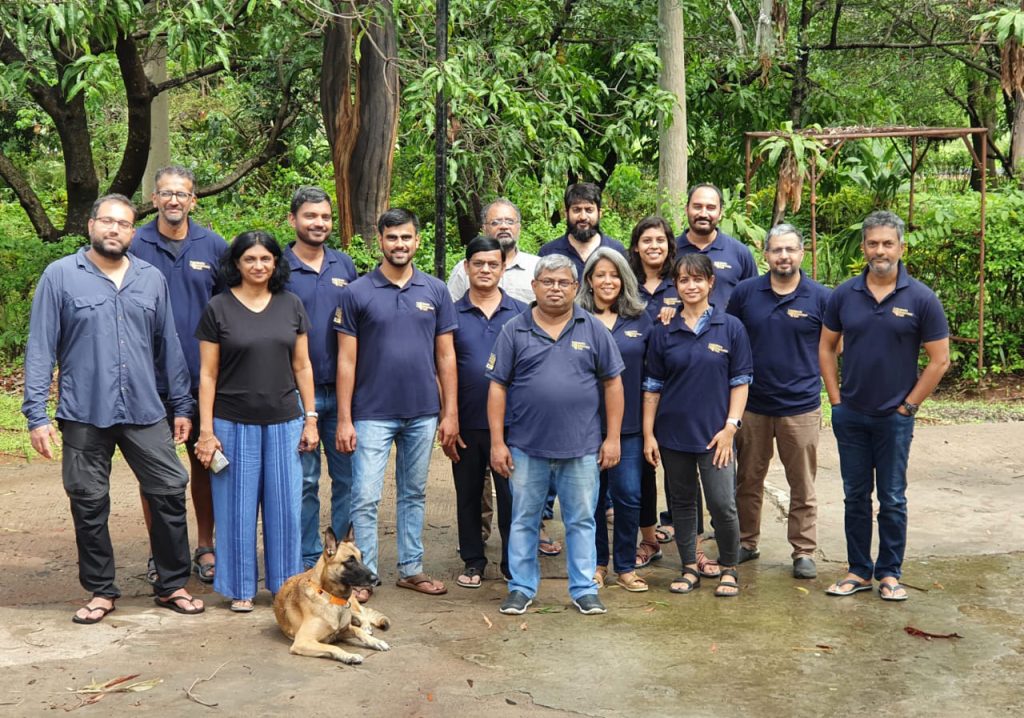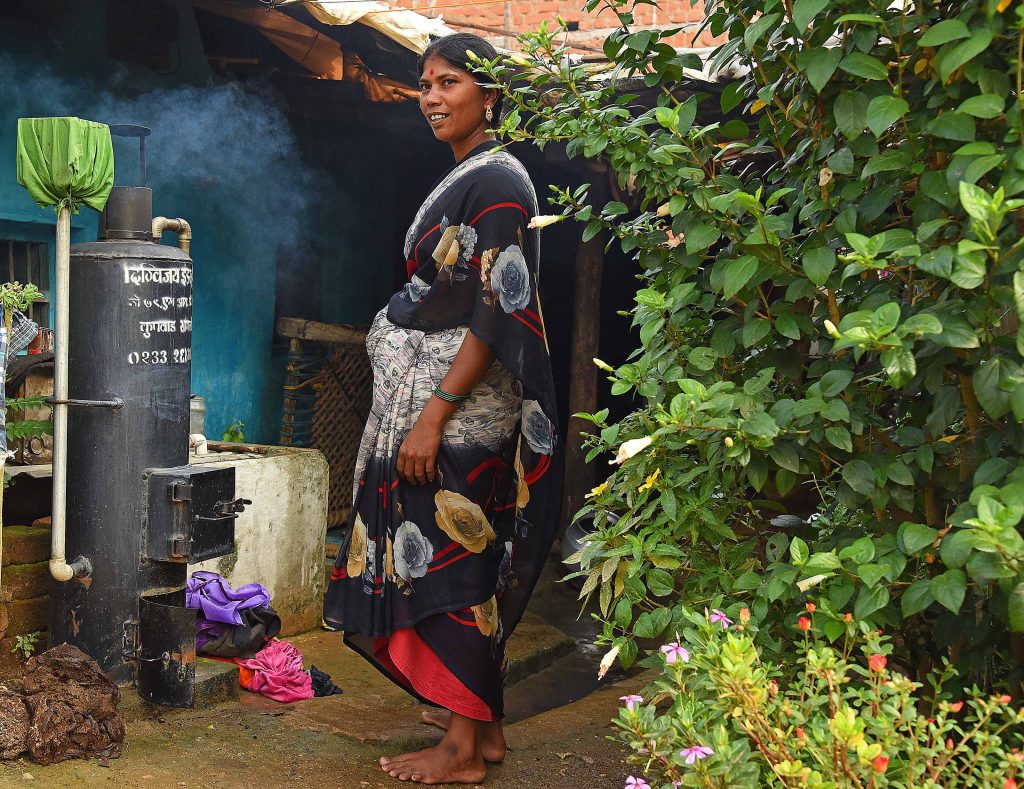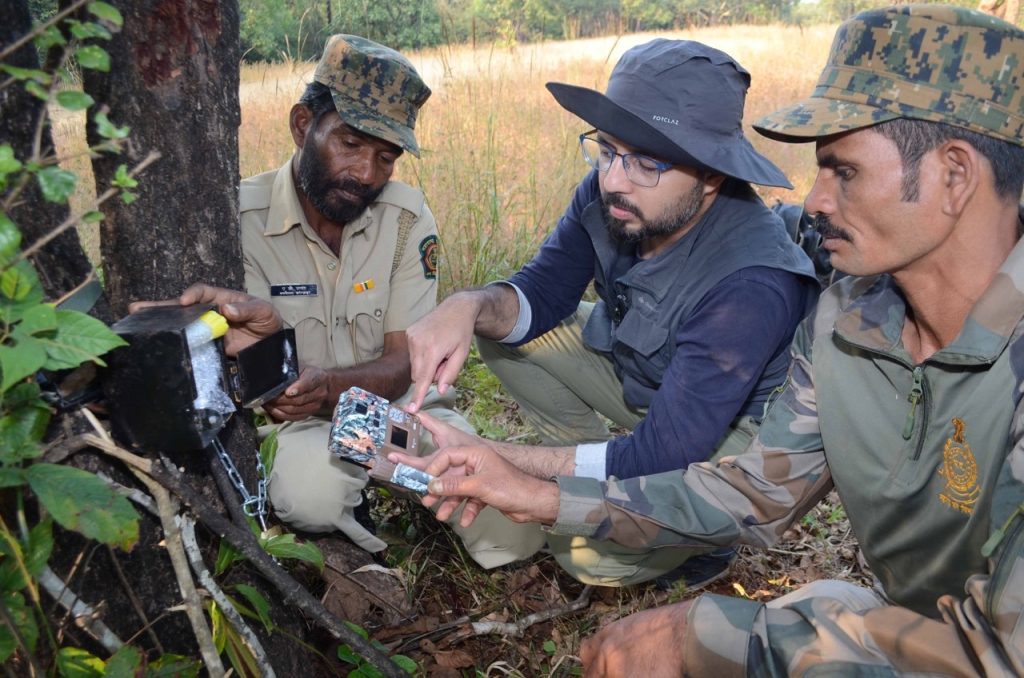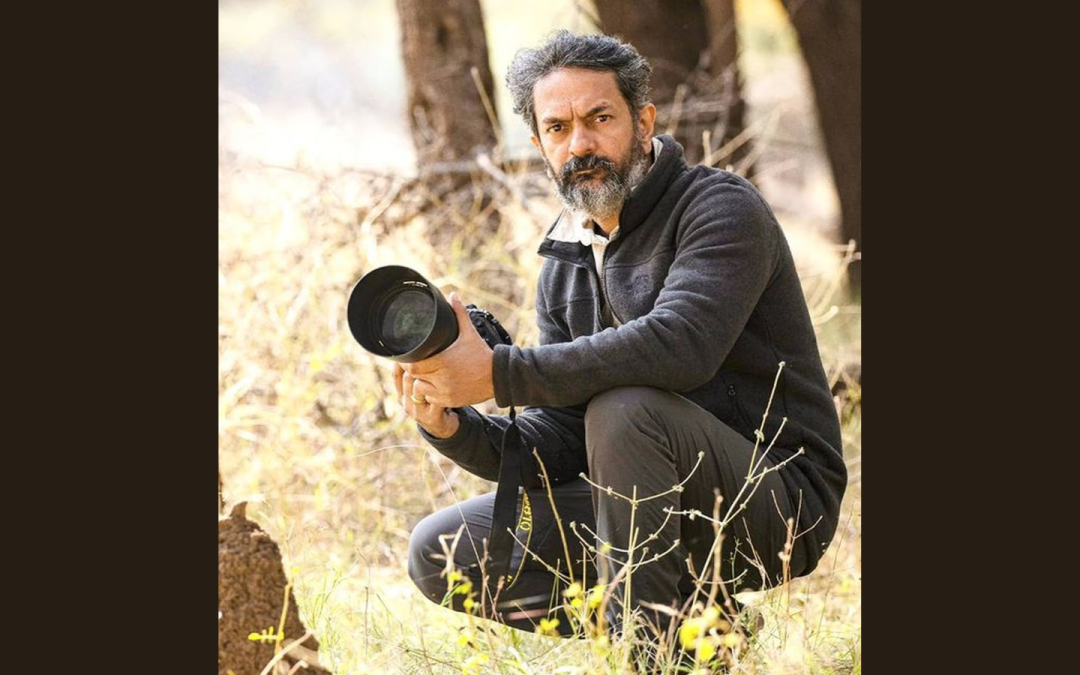A Carl Zeiss Conservation Awardee, Dr. Anish Andheria is the President of the SLTP partner Wildlife Conservation Trust (WCT) which uses a 360° approach to conservation by placing equal emphasis on both forest and wildlife conservation and community development. He is a large carnivore biologist with field expertise in predator-prey relationships and has co-authored two books on Indian wildlife and contributed to several other national and international publications.
He is also a member of the National Tiger Conservation Authority (NTCA) and has introduced thousands of people to the joys of nature and the rationale for nature conservation. On Global Tiger Day, he shares his thoughts on tiger conservation in India and on this and gives us an insight into his conservation journey.
- What is your background and what encouraged you to become a tiger conservationist?
My education has been in the areas of fluid mechanics and surface chemistry but I was very interested in wildlife since my childhood. I started rescuing snakes and other animals like crocodiles and birds when I was in grade 8. So my interest in nature was congenital actually. But as there was no good Master’s program, I took what came naturally to me and went for in for engineering.
However, my interest in nature continued and I started publishing a lot of work my work and did a lot of photography wherever I travelled. During my Master’s and PhD, I used to take a sabbatical and do a lot of tiger research work with Ulhas Karanth from the Wildlife Conservation Society. Post my Ph.D., I joined Sanctuary Asia and worked there for 9 years. And then in 2009, joined Wildlife Conservation Trust (WCT). I was the first employee there and then built the entire team. Now we are a team of around 90.
- What is the importance of tigers in the ecosystem?
Well like any other large carnivore, tigers sit at the top of the food chain and they can act as an indicator. They also keep a check on the herbivore densities and in a way regulate the entire ecosystem. To measure what’s happening with the ecosystem, instead of going and working with plants or looking at how many grass blades there are in the forest, it’s easier to study tigers. And if the tiger population does well, you know that everything else is fine. Obviously, if it doesn’t do well, then there are multiple things that may have happened. Therefore, tigers become a barometer, similar to top carnivores in other ecosystems. If you are in the Arctic, then you look at the polar bear. If you’re in the Amazon, then you look at jaguars and so on and so forth.
- What are the main threats to tigers and how have these threats impacted their population?
The biggest threat for tigers globally is the illegal trade in tiger body parts. There is a huge demand for every single body part of the tiger in China, Vietnam, and some other countries. This puts pressure on the population across the planet. In India we are doing pretty well, but globally not so much. India has more than 70% of all tigers and there are several threats to this population as well. The most important ones are forest degradation and fragmentation as habitat plays a very big role. Then there is direct poaching of tigers for international trade and poaching of prey for consumption within the country. In the absence of prey, tigers may attack livestock which may lead to conflict with people and tiger deaths. And also there are unintentional tiger deaths because of roads and electrocution. Electrocution is an emerging threat. It’s done by farmers to control the herbivore population and keep them out of their farms, but tigers and leopards fall prey to it. So these are the primary threats but climate change also is now a big threat because a lot of the habitat is changing now. There are phenological changes because of which the protected areas no longer have the same carrying capacity and this will have a long-term impact on tigers.
- What actions is WCT taking to address these threats?
WCT uses the tiger as a guiding light. We work on several species in several other habitats, but the tiger is why the organization was set up really it has guided us to get into serious landscape scale problem solving projects. We work on conflict mitigation between people and large carnivores, especially tigers. We also estimate tiger densities not only inside, but outside protected areas. In fact, I am pretty sure that WCT estimates tiger density in a much larger landscape outside protected areas than any other NGO on Earth. We cover about 8,000 to 10,000 km2 of corridor area every year and that gives us a lot of information on the challenges that wildlife faces in non-protected areas and challenges that people face because of carnivores. This allows us to weave in solutions that are far more holistic. We are also working with communities to reduce their dependence on the forest since if communities keep going to the forest, there is going to be conflict. So, we run an energy-efficient water heater project called the ‘Heater of Hope’ where we are trying to provide alternatives to fuel wood and that has really changed the way people use the forest. We try to understand the socio-economic & socio-cultural structures to see how behavioral change can be brought about in communities. The poorest of the poor rely on natural ecosystems for survival, thus they will not benefit if the forests go, but they are forced to destroy the forest because they have no other alternative. So that’s the area of interest and we try to approach it from many angles – science, social science, conservation biology, legal frameworks, and so on.
- Can you tell us about a typical day for you as a tiger conservationist?
My days are almost 15 to 16 hours long, not because I am forced to work that long but because I love what I do. I love to keep thinking about solutions, partnerships, strategizing programs, and working closely with my teams to kind of stitch some interesting strategies to solve conservation issues. And I am blessed to have a great team actually. Most of the hard field work is done by them. So my role is to try and weave all of those together, and also take it to the next level, which is to the policy makers. We work with the state and central governments and try and translate our research work into action. We are on several state boards of wildlife and also I am a member of the National Tiger Conservation Authority (NTCA). And so, all of our work is designed in such a way that it eventually translated into some larger change. It may work in a spark, but the idea is to see how it can be, implemented with obviously some amount of tweaking in other parts of the country as well. I also look at reports, read other people’s work, and coordinate with a lot of people within India and internationally, with the forest department, other NGOs, other researchers, and so on.

The WCT Team
- What have been some of WCT’s main successes?
So our tiger estimation program is the longest program that we have had. It’s been 11 years now and we have been doing it largely in the states of Madhya Pradesh and Maharashtra. This has translated into several successes in securing large landscapes and several parks for wildlife for posterity. There were people on the ground who always knew that these areas are important, but once we started conducting systematic studies, it added a lot of weight to what those people were saying. So, WCT, I would say, played a catalytic role in getting several new parks declared, getting the buffer zones expanded, getting the core expanded, and getting the corridors notified.
Secondly, the energy efficient water heater which we have worked on is a great contraption and now there is a huge demand for it in areas which have traditionally seen the highest interaction between people and tigers. These water heaters have reduced the usage of wood and carbon dioxide emissions in a big way.
Another project that we can take pride in and also capacity building. We have trained staff of several tiger reserves to estimate tiger densities and we’ve kind of built capacity and moved out. We then go and work somewhere else where there is a need.

WCT’s Energy Efficient Water Heater

Building Capacities of Forest Personnel
- What are the future plans of WCT?
We have very tall and difficult plans. If we can catalyse a movement that can secure 30% of India for nature, then we would kind of retire. We currently have 5.25% under the protected area network. A lot of other lands are there which are in reasonably good shape, but they are not really well protected. So we want to see how that can be done, and that obviously will need a lot of partnerships like the ones we are doing at the national level with other NGOs and the government.
We work with a lot of other endangered wild animals like gharials, Ganges river dolphins, pangolins, and Eurasian otters. Slowly, from hands-on work, we want to do more policy related work so that it has a wider impact. We also want to see how we can bring about transformation with quality data. We could partner with other organizations who have data and then try and integrate programs. We are thinking of partnering with the social organizations, and working to see how climate change can be tackled through several programs from the livelihoods and efficient agriculture perspective. The climate is changing rapidly. The monsoon is shifting. So, we feel that if we can move towards agroforestry, then there is a win-win on both sides.
So, those are big projects that we want to focus on going forward.
- Would you encourage the public to be hopeful for the future of tiger conservation/tigers?
I think the last tiger to walk on this land will be in India. I hope that does not happen in our lifetime. India is doing a lot of things right. However, there are 18 tiger states but tigers are doing well in about six or seven of them. So if tiger conservation has to be taken more seriously, then we need to see how we can improve and how can systems be adopted from within India. There are lots of success stories from the states which are doing well and other states can learn from them. There should be exchange programs. The better performing states should be incentivized. If that happens, then automatically other states will get inspired. Furthermore, tigers finally are barometers as I said, and having tigers in a forest will bring more focus to that particular forest, and as a result, other species will also benefit. And so, I think Project Tiger has done well so far, but there are challenges in the future and we need to see how these non-performing states perform.
- What is your most memorable encounter with a tiger?
I’ve had several encounters and have walked several thousand kilometres in tiger habitats in my lifetime. So, there are many tiger sightings that I have had on foot. One of those sightings was in Bandipur Tiger Reserve during my master’s while I was collecting data with a local assistant. We were walking down a slope and the road was cutting through a stream. The stream noise would have muffled our footsteps and we saw a male tiger sitting in the stream barely 20 meters from where we were. It was facing the other side. We saw the tiger before it saw us, and then obviously by default the tiger turned and looked at us and we didn’t know what to do because it was very close. Thankfully, it just crouched then stood up and went inside the forest. Immediately from there a few spotted deer and a four-horned antelope ran out and almost dashed against us because they too didn’t know that there was a tiger sitting there. So it was quite something and it speaks volumes about large carnivores, you know, how timid they are. So they are unnecessarily thought of as bloodthirsty beasts which is not true. Obviously, a tiger is not a gentleman but they are not bloodthirsty beasts either!
- Why are people and communities so important in conservation?
So, when we work on tigers, we really don’t interact with tigers. Tigers don’t understand our language. We claim that we know what they need, but if we had known, then human beings would have done better for them. Since our knowledge is also fuzzy, the only way we can influence wildlife is by working with communities. I have a huge respect for people living in and around the forest, especially in India because they really pay the opportunity cost of conservation and yet they don’t go about killing wildlife. So it’s very important that their inherent love for nature stays intact. This means with the kind of aspirations of the next generation and with the exposure that children in those communities have today, it is our responsibility to ensure that as we progress, we take care of their aspirations. At the same time, we make sure that their interaction or their connection with the forest stays intact because without people’s support, we will not be able to protect the forest or tigers. Protection is one thing but I would give the culture, the resolve and the tolerance of the communities 70% of the credit, 30% of it goes to protection.
If you have one piece of advice for budding conservationists, what would it be?
Conservation is very complex. The more you work on it, the more tough it gets because you realize that there is no easy and permanent solution. So you have to be adaptive, you need to be humble, and egos have no room here. You cannot dislike human beings and say, you know, I love wildlife, I hate human beings. You have to think about people. Unless you can create programs that are good for people, you will not be able to save wildlife. You cannot justify saving wild animals if people are going to die either out of starvation or if they fall prey to wildlife. So budding conservationists will have to have a balanced mindset, no ego, and be ready to learn and be flexible, but non-compromised.
- How can we, in our daily lives, help tigers?
I think the people living in and around the forest are doing a lot for the forest because they are hardly using electricity, they recycle pretty much everything they use, and they grow what they eat, so it’s all local. So we have to learn from them and lead a lifestyle where we can buy things that are local. And obviously, conserve electricity and water. All these things are clichéd, but they are important. Also if you can, try and allocate at least 5 to 10% of funds for conservation. Companies can easily allocate about 10% if they really want to. They get much more from the environment- the water, the oxygen that nature gives them for free. Whereas, individuals can either contribute financially or volunteer work with organizations. If you are an accountant, assist an NGO and improve its accounting system. So no matter where you are, whether you’re a writer or painter or whatever profession you are in, if you love wildlife, you will yourself know what to do. It’s not like going into the forest and doing camera trapping or working on tigers with some NGO is the only way to contribute. There are so many different ways. Use less, reuse much more, walk a lot, and live a healthy lifestyle. And I think healthier people find healthy solutions.
- What is your favourite thing about your job?
I would say that I get paid to learn every day. I get to pay the rent of living on the planet by doing something for the water, the oxygen, and the food that am taking in every day. So I feel that I am very fortunate that I can directly repay. I know that I may not be able to repay everything that I take from nature but at least my profession allows me to go to sleep satisfied that I am not ignorant of the freebies that I get from nature.
- What has been your experience of working with Born Free as a part of Satpuda Landscape Tiger Partnership?
Born Free is acting as a glue to bring together a number of NGOs that are doing good work, but if not for Born Free, would have worked in isolation. As there is an inherent lack of funding everywhere, NGOs are generally busy with other tasks and hardly have any time to partner. Especially the ones working on action-oriented projects. So I believe the biggest benefit of Born Free has been in this partnership where people working in the same landscape have come under a common roof and are interacting more than they were doing before. So full credit goes to Born Free for that.
- Why is Tiger Day important for tiger conservation?
For people working in the conservation space, every day is a day of importance. But to get the eyeballs of people from different walks of life, this day is particularly important. From the newspapers to the radio, to television, everybody talks about tiger conservation on this day. The day is also significant as people from other countries too get to know about tiger conservation through various forums and there could be a lot of positives to take away from what is being done here in India.
So Global Tiger Day is an opportunity where India can talk about the ways of reversing the tide for conservation.
- Is there anything you would like to say to Born Free Foundation (BFF) supporters?
First of all, I am humbled that BFF supporters who may not know much about the organizations that BFF supports are supporting BFF so that they can do what they are doing here in India. So I would request them to continue to support BFF so that they can continue to strengthen organisations not only in India but also in other regions where BFF is working. Their financial support will go a long way. It would be great if they could talk to other people who have the resources and want to do something for conservation and encourage them to support organisations like BFF who are working in not only the country in which their head office is, but also several other nations.

